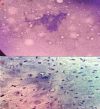Malignant Peripheral Nerve Sheath Tumor Presenting as Horner's Syndrome
- PMID: 34722092
- PMCID: PMC8551934
- DOI: 10.7759/cureus.18341
Malignant Peripheral Nerve Sheath Tumor Presenting as Horner's Syndrome
Abstract
Malignant peripheral nerve sheath tumor (MPNST) is a rare, aggressive sarcomatous tumor that arises from peripheral nerve sheath and shows Schwann cell differentiation. They are commonly seen among cases with existing benign plexiform neurofibromas, prior radiation treatment, and large germline mutations involving the entire neurofibromatosis 1 (NF1) gene. MPNST can have varied presentations; hence diagnosis remains a great challenge. Here we report a rare case of MPNST in an NF1 patient who presented with Horner´s syndrome. A young male reported swelling in the neck, dyspnea on exertion, and dysphagia. Subsequently, he was diagnosed to have a malignant peripheral nerve sheath tumor arising from the mediastinum and compressing the ipsilateral cervical sympathetic plexus causing Horner's syndrome. The patient underwent surgical resection of the mediastinal mass followed by chemotherapy. His symptoms improved significantly following treatment. This case report emphasizes the fact that high suspicion of MPNST is required when NF1 cases present with mass lesions, so that early surgical clearance with chemoradiation may offer a near-complete cure.
Keywords: brachial plexopathy; horner’s syndrome; malignant peripheral nerve sheath tumour; neurofibromatosis 1; sarcoma soft tissue.
Copyright © 2021, Azharudeen et al.
Conflict of interest statement
The authors have declared that no competing interests exist.
Figures


Similar articles
-
Malignant peripheral nerve sheath tumour presenting with Horner's syndrome.J Assoc Physicians India. 2013 Sep;61(9):661-3. J Assoc Physicians India. 2013. PMID: 24772708
-
Vascular endothelial growth factor, basic fibroblast growth factor and epithelial growth factor receptor in peripheral nerve sheath tumors of neurofibromatosis type 1.Anticancer Res. 2015 Jan;35(1):137-44. Anticancer Res. 2015. PMID: 25550544
-
Malignant peripheral nerve sheath tumor of the spine after radiation therapy for Hodgkin's lymphoma.Clin Neuropathol. 2004 Sep-Oct;23(5):245-55. Clin Neuropathol. 2004. PMID: 15581029
-
Multimodal Imaging in Neurofibromatosis Type 1-associated Nerve Sheath Tumors.Rofo. 2015 Dec;187(12):1084-92. doi: 10.1055/s-0035-1553505. Epub 2015 Sep 2. Rofo. 2015. PMID: 26333104 Review.
-
Malignant peripheral nerve sheath tumor with Horner's syndrome: a case report.Ann Thorac Cardiovasc Surg. 2008 Aug;14(4):246-8. Ann Thorac Cardiovasc Surg. 2008. PMID: 18818575 Review.
Cited by
-
Unilateral Increased Brown Fat Activities on 18F-FDG PET/CT in a Patient with Contralateral Anhidrosis After Surgical Treatment of Metastatic Osteosarcoma in the Upper Thoracic Spine.Nucl Med Mol Imaging. 2024 Aug;58(5):319-321. doi: 10.1007/s13139-024-00853-6. Epub 2024 Feb 21. Nucl Med Mol Imaging. 2024. PMID: 39036456 Free PMC article. No abstract available.
-
Horner syndrome immediately after deep dissection of upper thyroid pole: a case report and review of the literature.Innov Surg Sci. 2024 Feb 2;9(1):63-66. doi: 10.1515/iss-2023-0056. eCollection 2024 Mar. Innov Surg Sci. 2024. PMID: 38826629 Free PMC article.
References
-
- Malignant peripheral nerve sheath tumors associated with neurofibromatosis type 1. Bilgic B, Ates LE, Demiryont M, Ozger H, Dizdar Y. Pathol Oncol Res. 2003;9:201–205. - PubMed
-
- Birth incidence and prevalence of tumor-prone syndromes: estimates from a UK family genetic register service. Evans DG, Howard E, Giblin C, et al. Am J Med Genet A. 2010;152:327–332. - PubMed
-
- Neurofibromatosis type 1 revisited. Williams VC, Lucas J, Babcock MA, Gutmann DH, Korf B, Maria BL. Pediatrics. 2009;123:124–133. - PubMed
-
- Neurofibromatosis type 1 presenting with Horner's syndrome. Cackett P, Vallance J, Bennett H. Eye (Lond) 2005;19:351–353. - PubMed
Publication types
LinkOut - more resources
Full Text Sources
Research Materials
Miscellaneous
